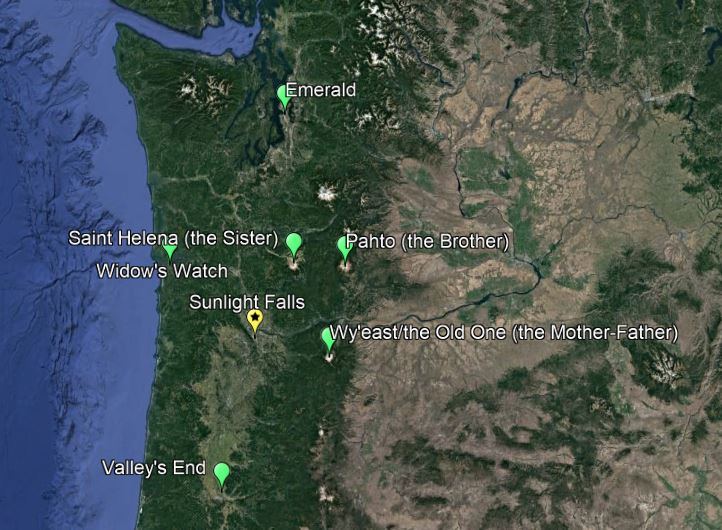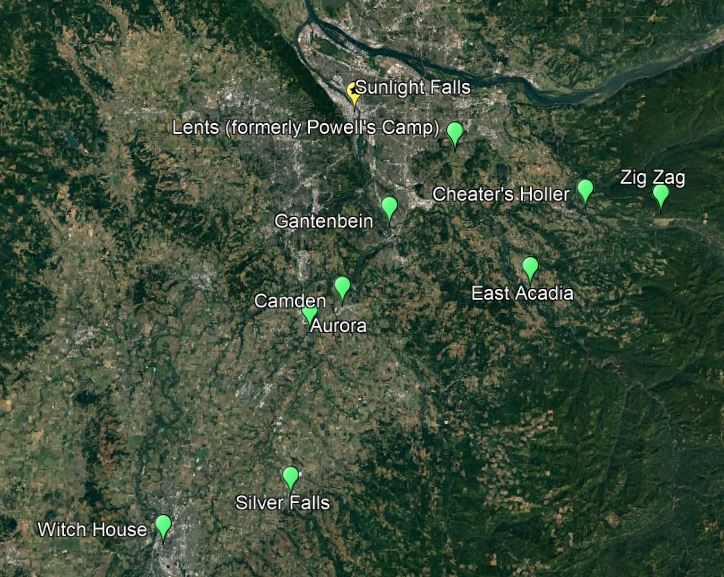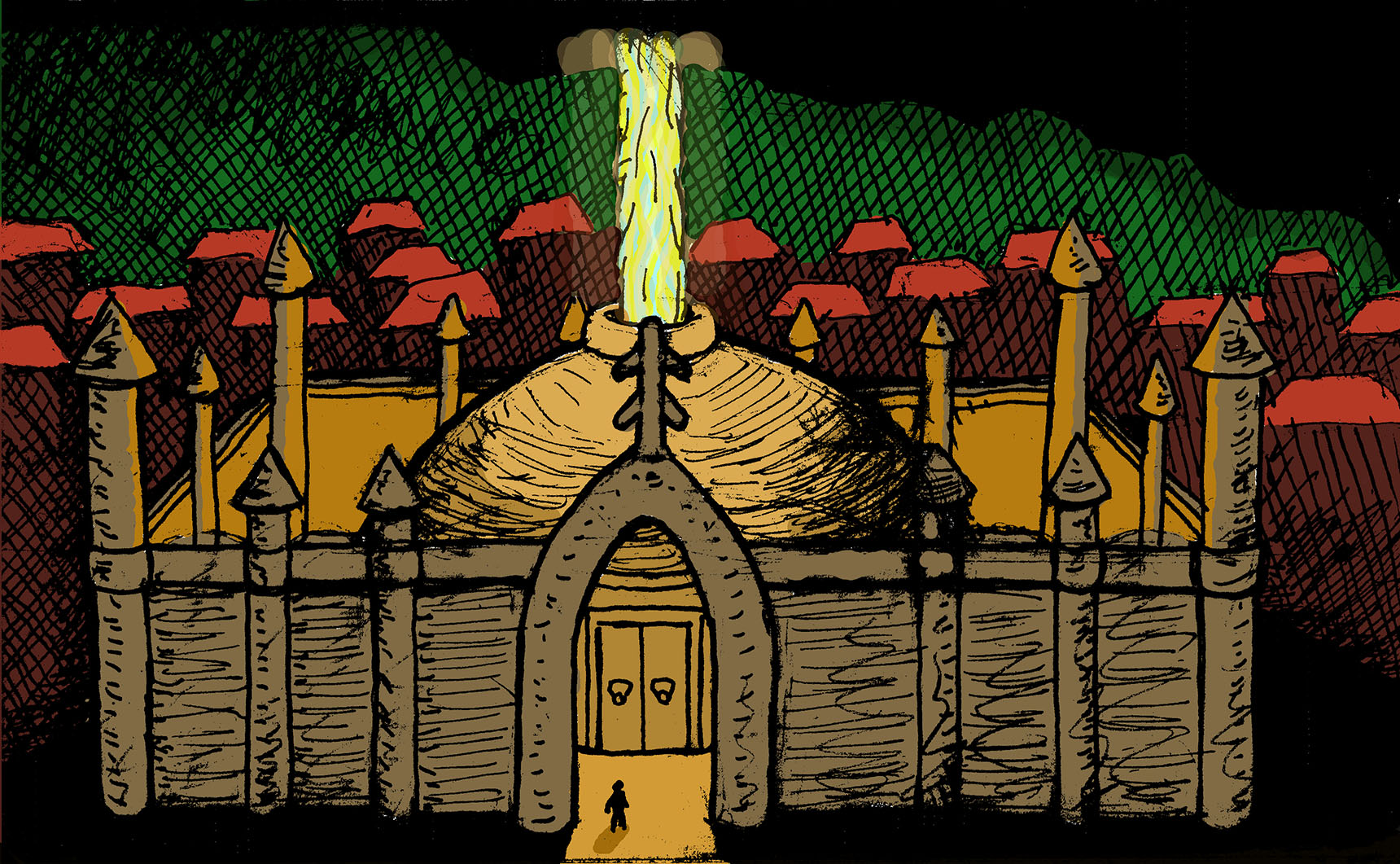When I first started running D&D games back in 2012, I put a lot of time into thinking about the region of the fantasy world that our characters would exist in, and I have continued to develop that world over the passing years. This page serves as a repository of common knowledge the characters in the game would know about their world.
Geography
The most notable thing about the world of Sunlight Falls is that the geography mirrors that of the real world. I did this in order to have players quickly understand what the world looked like, to have a good sense of distance between places, and to be able to relate easily to the fantasy environment.

Rivers and other bodies of water
There are several waterways that regularly appear in the game. Here is a list of water features with their real world equivalents:
- The Tears of the World (Columbia River): This massive river, spanning a mile from shore to shore, creates a physical barrier between the north and south parts of this land. To the north are thick, uninhabited forests, and beyond that, the magical kingdom of Emerald. It is navigable by any ocean vessel that is able to pass through the dangerous mouth of the river. Looking over the mouth of the Tears of the World is the port city of Widow’s Watch.
- Greyglass River (Willamette River): While much smaller than the Tears of the World, the Greyglass River is still a major waterway, and serves as a separator between the human city of Sunlight Falls and the elven city of Yllodah. It is navigable by ocean going vessels, allowing the city of Sunlight Falls to have a bustling harbor.
- Powell’s Creek (Johnson Creek): Powell’s Creek only runs a few feet deep, and ranges between 15′ to 30′ feet in width. It is navigable by small boats and rafts only in the late spring and early summer months. Powell’s Creek marks the northern border of the town of Lents, dividing it from the Elvish Woods.
- Mollabish River (Clackamas River): The Mollabish is a sluggish river easily navigable by boat for the first twenty miles after it empties into the Greyglass. As it passes through the higher lands that lead to the Dragonsteeth Mountains, the river becomes more shallow and rapid, and go only be navigated by going downstream. The human anti-magic community of East Acadia is located on the north banks of this river.
- Sucker Lake (Oswego Lake): The real world original name of Oswego Lake was “Sucker Lake”. No joke. Sucker Lake’s water levels fluctuate heavily throughout the year, but is rarely ever more than five feet in depth.
Mountains
Here is a list of mountains and their real world equivalents:
- The Elksteeth Mountains (Coastal Range): Beyond the range of the Elksteeth Mountains lies a land known as the Seaside Kingdom. Not much is known about the Seaside Kingdom beyond their use of slaves and their practice of clearcutting vast swaths of forests.
- The Dragonsteeth Mountains (Cascade Range): This range includes the mountains of Wy’Eaast, Saint Helena and Pahto. Very few of the inhabitants of this region have ever been beyond the Dragonsteeth
- The Old One/Wy’East (Mount Hood): Also home to a large city of dwarves who refer to both the mountain and their community as the “Mother-Father”.
- Saint Helena/The Sister (Mount St Helens)
- Pahto/The Brother (Mount Adams)
The Bountiful Valley
The hundred mile stretch of land between the Elksteeth and the Dragonsteeth Mountains is called the Bountiful Valley, or more commonly, just the Valley. This is the home to most of the humans, elves, gnomes, and goblins of the region. Although it is called the Valley, it comprised of many different biomes, such as small foothill ranges, marshland, prairies, deciduous forests.

The Beam of Light
The most significant feature of the Bountiful Valley is the beam of sunlight that spontaneously came into existence on a spot of collapsed ground 323 years ago. Regardless of time of day, this spot of earth has constantly been bathed in daylight ever since. Over time, a shrine was built around the spot of earth, and a city formed around the shrine. This is the city of Sunlight Falls. Over the centuries of the beam’s existence, a theological argument has formed among the worshipers of Pelor, with one sect believing that the beam descends from the heavens, while the other sect believes that it ascends to the heavens. At night, the beam of sunlight can easily be seen as far as sixty miles away in good weather, and as such is considered a reliable landmark for navigation.

For generations, the Mollabish and Walato peoples had stories that predicted that such a beam of light would one day appear. These stories foretold that the beam would be a destructive force, signalling the end of their civilizations. In the decades that followed the appearance of the beam, the Mollabish and Walato civilizations were ravaged by diseases and sickness, killing nearly 90% of their population. Three hundred years later, both groups of people still exist, but the beam is a constant reminder of the turning point in their prosperity.
The elves of Yllodah also had portents in their culture of the coming of a beam of light, but this was never regarded as anything more than a mystery or a fascination. The older omens of the beam indicated that it would herald a time of change, but for the generations that were alive when the beam appeared, it was embraced with a sense of relief. As the Yllodah people are secretive about themselves, not much more is known about their thoughts and opinions about the beam.
For the Etonians that have migrated here, the beam is seen as evidence of the power of Pelor. The beam first appeared during a time when the very first Etonians were exploring this part of the world, and happened very nearby the first explorers. This group of people stayed to build a small shrine around the light, and over time brought others on pilgrimages to the site. The city of Sunlight Falls grew to what it is from this stream of pilgrims.
The Humanoids of the Region
First off, let’s not call them “races”, which is a word that is loaded with connotations but also doesn’t do very well to describe the varieties of humanoids. In this region of the world, the predominant types of humanoids are humans, elves, gnomes, goblins and dwarves. Also present, but much less frequently encountered, are halflings and orcs, two types of humanoids that are more prevalent farther south.
Humans
Etonian
The Etonians hail from the far eastern part of the continent that they refer to as “the New World”, from a kingdom called Eton. Over the three centuries that have passed since they first started exploring this part of the world, they have become the primary culture of humans in this region. Etonians tend to be worshipers of Pelor, and are not known for being particularly gifted in the arcane arts. From their central community of Sunlight Falls, they have expanded to smaller communities all over the Valley.
Mollabish
Indigenous people of the area. Practice farming and trading, historically do not have fixed settlements.
Walato
Indigenous people of the area. Practice fishing and trading, have fixed settlements along the lower parts of the Tears of the World (known as the Heartless Giver in their language). Practice slavery. Easily identified because of their practice of forehead sloping.
Emerald
Dark-skinned humans from far-away lands. Exceptionally gifted in the arcane magics.
Yohai
People from the other side of the ocean.
Elves
Wood Elves
High Elves
Gnomes
Inventive, inquisitive, and totally on the autism spectrum.
Goblins
Span the spectrum.
Dwarves
These folks stay underground for the most part.
Halflings
People from lands from the south.
The Valley Settlements
Sunlight Falls (Downtown Portland)
With a population of over 25,000, Sunlight Falls is by farther the largest community of people in the valley. It was founded by Etonian followers of Pelor in the years following the construction of the Shrine of Sunlight Falls, and has grown into a predominantly human community with a diversity of political and religious beliefs. Under the rule of the Woman King, Elspeth Smith, the culture of the town has become xenophobic and very unwelcoming to elves.
Notable Places in Sunlight Falls
- The Free Basement Publican – Home to the Explorer’s Club, run by a mysterious man named Jareth, and the only establishment in Sunlight Falls that is staffed by goblins.
- Billy Burnside’s Treasure Chest – The best general store and junk shop in the city.
- Lounge of the Lotus Eaters – A good place to get noticed by member’s of the city’s crime syndicate.
- Raven’s Watch – Headquarters of the city guard, the jails, and the city’s administrative employees.
- Temple of Coin – For those with the money, this is the stock market and central bank. Operates independently of the city or the Woman King.
Lents (Far Southeast Portland)
With over 2000 people, this is the second largest community of people in the valley.
Yllodah (Inner East Portland)
This is the largest elven community in the valley.
Cheater’s Holler (Sandy)
A small community of about 60 people. The town was destroyed and most of its populace died in mysterious circumstances last year.
Camden (Canby)
Aurora (Aurora)
Silver Falls (Silverton)
Witch House (Salem)
Valley’s End (Eugene)
xxx
The Gods
Most of the gods in our game’s pantheon come from the World of Greyhawk, but they have all been slightly modified from the original source. Only the more commonly worshiped gods are listed here. Most people that are religious choose to focus their worship on just one god, although many pray to other gods when they feel the need. Many people don’t care about the existence of the gods and choose not to worship any of them. Very few people don’t believe in the existence of the gods.
Pelor (Lawful Neutral)
Pelor is the god worshiped by the majority of the human population of Sunlight Falls and the surrounding area. Pelor is considered to be a life-giving, benevolent god, protecting its worshipers and providing a common foundation for civilization.
The Might of Pelor
Adherents of the Might of Pelor believe that Pelor provides everything in the world to them, and empowers them to take it for themselves.
The Hand of Pelor
Ehlonna
Nature goddess, but generally reviled by druids.
Coin
Capitalism has its powers.
Fharlanghn
God of travelers. Actually walks the earth.
Wee Jas
God of death. Many worshipers are undertakers, coffin makers, or other professions that care for the dead.
Recent Events
The South Valley War
In the year 317, an army of gnolls and hill giants came through a pass in the Dragonsteeth and invaded the southern part of the valley. In the incredible violence that followed, the entire town of Valley’s End fell and is believed to have been destroyed. The force of gnolls and giants came up the valley to as far as Aurora before they were finally beaten back and destroyed by various groups of humans, gnomes and elves. In the few years after the war, the towns in the northern part of the valley grew in size as they took in people from the south who had lost their homes and livelihoods.
The Woman King
Ever since the founding of the city of Sunlight Falls, the city was ruled by a city council. The city council was configured in different ways over the centuries – sometimes as a group of three, sometimes as a group of seven, but usually as a group of five. There was no mayor or appointed leader of the council – all council members represented the city equally. This changed in 321 when Councilwoman Elspeth Smith killed her rival, Councilwoman Eladora Nicks, and chased Councilman Thomas Dryer out of the city. With the (possibly forced) complicity of Councilman Colin Fiske and Councilwoman Elsea Hoyt, Councilwoman proclaimed herself the Woman King of Sunlight Falls and dissolved the city council.
Under the Woman King’s rule, adventuring parties were banned. Prostitution was banned as well, but it is an open secret that this is largely disregarded. Many fees and licences have become more expensive (sometimes by as much as a hundredfold), preventing them from being paid or maintained by only the wealthy. Over the past two years of her rule, the existing upper class has flourished while the merchant classes and working class people have had a harder time making a living for themselves.
The Lents Uprising
Game Rules
The Dead Walk
While not very well known or understood by the general populace, seasoned adventurers know that the dead tend to rise in undeath if the corpses are not given proper attention.